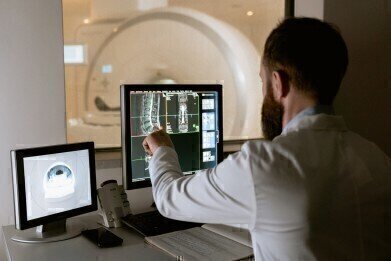Laboratory Products
What Questions Can I Answer with Nuclear Magnetic Resonance?
Aug 19 2014
Nuclear magnetic resonance (NMR) is a physical process that occurs in some nuclei when they are subjected to electromagnetic fields. The process is used in chemistry as NMR spectroscopy and in medicine as magnetic resonance imaging (MRI).
Chemistry
NMR spectroscopy is widely used in organic chemistry in conjunction with other spectroscopic techniques to determine a molecule’s structure.
NMR can indicate how many of the target nuclei can be found in each of the different environments in a molecule. It can also show what types of environment are in the molecule by showing how much shielding — due to other nuclei and electrons — is taking place.
For example, if a sample of ethanol, C2H5OH, were investigated in hydrogen NMR, the numbers of hydrogen nuclei in each different environment, and information about each environment would be shown.
There are three different hydrogen environments in ethanol; these are the methyl (CH3) group, ethyl (CH2) group and hydroxyl (OH) group. The hydrogen’s in the methyl group are considered equivalent — they each feel the same strength of magnetic field. As a result NMR cannot distinguish between them. The same is true of the ethyl group.
Therefore there would be three different peaks representing the three different environments in ethanol. The peaks would be spaced along the baseline with the separation determined by the shielding each hydrogen nuclei feels.
NMR reveals how many target nuclei are in each environment using the ratio of the area under each peak. For ethanol the three peaks would be in the ratio 1:2:3:
- -OH, one hydroxyl hydrogen
- -CH2, two ethyl hydrogen
- -CH3, three methyl hydrogen
Using this information, a molecular structure can be confirmed or determined.
Medicine
Magnetic resonance imaging (MRI) scans make use of the NMR process. MRI is widely used as a diagnosis and imaging technique in hospitals. As MRI is non-invasive, and doesn’t use any ionizing radiation or radioactive tracers, it is considered a safe option.
Proton NMR (1H NMR) is used when looking at the nervous system or brain disorders. MRI is more effective than other techniques when looking for neurological tumours and can be used to determine blood flow in the brain and so find any blockages. The ability of MRI to diagnose neurological injuries is discussed in: MRI can locate brain injuries in concussions.
MRI is also widely used in cardiovascular studies, where it can be used to provide real-time images of the heart. This can allow diagnosis of conditions including abnormal heartbeat and problems due to restricted blood flow.
Functional MRI — fMRI
This technique maps the brain whilst the person is given a stimulus. The technique uses the ability of MRI to distinguish between oxygenated and non-oxygenated blood. As the stimulus is applied, the relevant brain areas work harder as they respond, and so require more blood.
The results of these studies are aiding research into brain function and may aid researchers in better identifying which areas of the brain control what functions.
Digital Edition
Lab Asia 31.2 April 2024
April 2024
In This Edition Chromatography Articles - Approaches to troubleshooting an SPE method for the analysis of oligonucleotides (pt i) - High-precision liquid flow processes demand full fluidic c...
View all digital editions
Events
Apr 28 2024 Montreal, Quebec, Canada
May 05 2024 Seville, Spain
InformEx Zone at CPhl North America
May 07 2024 Pennsylvania, PA, USA
May 14 2024 Oklahoma City, OK, USA
May 15 2024 Birmingham, UK


.jpg)















